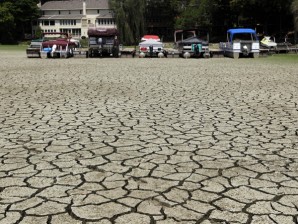
Boats sit on the dry, cracked bottom in a dry cove at Morse Reservoir in Noblesville, Ind., Monday, July 16, 2012. The reservoir is down nearly 6 feet from normal levels and being lowered 1 foot every five days to provide water for Indianapolis. The nation’s widest drought in decades is spreading, with more than half of the continental United States now in some stage of drought and most of the rest enduring abnormally dry conditions. AP/Michael Conroy
WASHINGTON—A drought scouring the farming heartlands of the United States is the worst for 25 years and could drive up food prices, Agriculture Secretary Tom Vilsack said Wednesday.
The United States is the world’s biggest producer of corn and soybeans, and the warning came as some farmers warned they may be forced to harvest crops early to sell the stalks off cheaply as animal feed.
“I get on my knees every day and I’m saying an extra prayer now. If I had a rain prayer or a rain dance I could do, I would do it,” Vilsack told reporters after briefing President Barack Obama on the crisis.
Vilsack revealed that 78 percent of US corn and 11 percent of soybean crops had been hit, and compared the situation to a 1988 drought that cut production by 20 percent and cost the economy tens of billions of dollars.
“This will result in significant increases in prices for corn. We’ve seen a 38 percent increase since June 1 in the price of a bushel of corn — it’s now $7.88. A bushel of beans has risen 24 percent,” he said.
Vilsack said the intensity of the drought was not as great as in 1988 but 61 percent of the country is affected, a much larger area than 25 years ago.
“Part of the problem we’re facing is that weather conditions were so good at the beginning of the season that farmers got in the field early,” he warned.
“As a result, this drought comes at a very difficult and painful time in terms of their ability to have their crops have good yields.”
The secretary said the government had increased the number of territories designated as drought disaster zones, bringing the total to 1,297 counties in 29 states, where farmers will be eligible for assistance.
Vilsack said Obama had ordered that the interest rates on emergency loans for farmers be reduced and that emergency areas be opened up for livestock grazing and hay production as feed costs rise.
But he said consumer food prices should not rise immediately, since the costs from the farm door are a small proportion of a final supermarket bill, and in any case it will take a while for the crisis to reach store shelves.
“There is some degree of uncertainty about all of this,” he said.
“Technology has allowed us to have more drought-resistant crops. The spotty nature of drought, the spotty nature of rains can sometimes result in better yields than anticipated. We’re just going to have to see.”
The US Federal Reserve’s latest report on economic conditions, the Beige Book, released Wednesday recorded wide variations in drought conditions, but noted a drop in the amount of corn being turned into biofuels.
The World Bank has said it is watching how the drought impacts global food supplies, after sharp surges in food prices in 2008 and 2010 dealt harsh blows to poor, food-importing nations.
“While it’s too early to be overly concerned, the Bank is monitoring the situation closely for potential impacts on our clients,” said Marc Sadler, team leader for the World Bank’s Agricultural Finance and Risk Management Unit.
“Global stocks in most of the tradable grains are lower now than they have been historically… we don’t have as much in the larder as we used to.”
Since June, temperatures have topped 100 degrees Fahrenheit (38 Celsius) for several days in a row in many parts of the central United States.
Mark Svoboda of the National Drought Mitigation Center in Lincoln, Nebraska said the drought was as tough as the worst in the 1930s and 1950s.
The timing has been particularly devastating, coming just at the peak of the growing season with the epicenter the central US farm belt east of the Rocky Mountains all the way to the Atlantic coast.
Farmers are now looking at cutting their losses by chopping down fields of half-mature, earless corn to feed the stalks to cattle.
“The jury is still a little bit out on it. We are in that process right now, making that decision,” said Steve Foglesong, who raises cattle and corn in Illinois. “From the road the corn looks green, but there are no ears on it.”
Foglesong said the next two weeks will be crucial, but weather forecasters were not encouraging.
“It’s just been bone dry,” said AccuWeather meteorologist Carl Erickson.
“Unfortunately across the central plains, the Mississippi valley, it looks like the overall pattern will remain in place for the rest of the month and into August. Once you get into a pattern like this, it almost feeds on itself.”